How to plant onions correctly and to what depth for the winter
Onions are one of the most common crops for growing not only in Russia, but all over the world. It is unpretentious in care, does not require special agrotechnical techniques that are difficult for novice farmers. Often, a crop deficit occurs already at the beginning of autumn, so many plant a vegetable before winter. How to do it correctly - we will tell in the article.
The content of the article
Landing features
For cultivation before winter, varieties with resistance to low temperatures are used. Under the snow, plantings should go with at least 5-7 leaves so that the bulbs wait out a long period of dormancy.
To protect against early frosts, the site is covered. To reduce crop losses, the crops of winter onions are increased by about 1/10.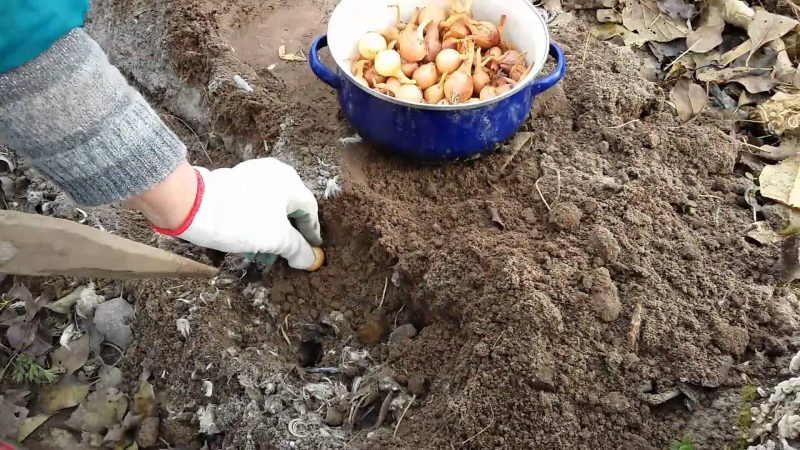
Varieties and hybrids
Among winter crops varieties of onions popular:
- Shakespeare;
- Senshui;
- Centurion F1;
- Struton;
- Strigunovsky;
- Red Baron;
- Snowball;
- Buran;
- Robin.
Planting varieties that are not intended for winter cultivation will result in heavy bulbs shooting in the spring and loss of yield.
When to plant onions before winter
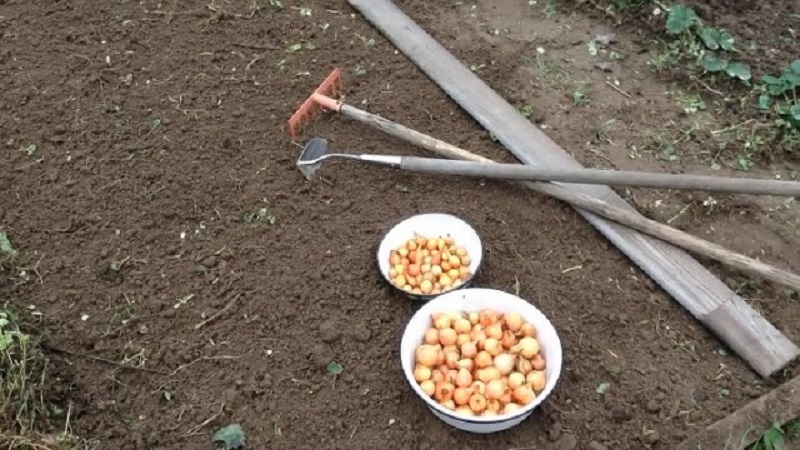
For winter cultivation, it is important to choose the timing correctly: planting too early will lead to the growth of vegetables, late planting will not allow them to take root. In both cases, most of the plants will die.
When determining the timing, the climatic conditions of the region and the botanical features of the onion are taken into account. The optimum average daily temperature for planting crops in most regions is around + 5 ... + 7 ° C.
Important! The bulbs take root within an average of 2–2.5 weeks.
Landing dates depending on the region
For the southern regions, the dates vary within the last decade of October to mid-November. If autumn is cold, onions are planted earlier.
In central Russia, sowing is carried out mainly in October, less often in early November, if weather conditions permit.
In the Urals, winter onions are treated with caution because of the risk of a sharp drop in temperature in the fall and weathering of the snow cover. Planting dates in the region fall on the junction of September and October, but the site is sheltered from frost.
In Siberia, the crop is mainly planted in the spring. Winter sowing is carried out no later than the end of September. The beds are covered not only for the period of autumn frosts, but also under the snow.
Landing technology
The yield of winter crops depends both on the correctly selected variety and on agricultural technology. The soil must be fertile enough for the bulbs to take root. Nutrient-poor soil will not allow the root system of plants to form, and the crop will die.
Crop rotation
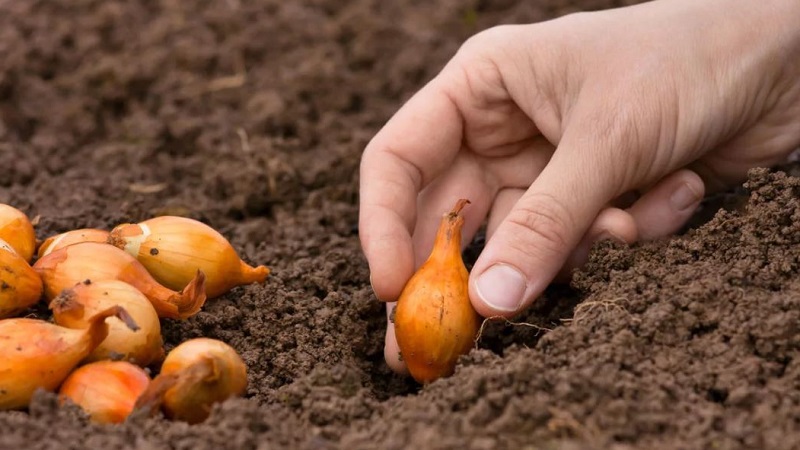
Correct crop rotation will allow you to get a bountiful harvest, protect the soil from pests and diseases. Properly selected predecessors will retain a certain acidity of the soil.
Onions are planted after:
- cucumbers;
- legumes: peas, beans;
- rapeseed;
- beets;
- mustard;
- pumpkins;
- zucchini;
- tomatoes.
Bad predecessors: spring onions, any kind of garlic, radish, rutabagas, cabbage, celery, carrots, parsley, parsnips. These crops severely drain the soil, especially in terms of nitrogen and phosphorus required for root and leaf formation.
Important! After potatoes, alfalfa, clover, there is a high risk of nematode infection.
Preparing the garden
The site is chosen protected from the winds, well lit, where snow melts quickly in spring and melt water does not stagnate. The soil should be loose with a neutral acid-base balance.After harvesting the predecessor crop, the soil is enriched with mineral and organic fertilizers, preferably at the time of the first digging.
To do this, use:
- humus or compost (one bucket per 1 m2 of soil);
- superphosphate (2 tbsp. l. per 1 m2) or wood ash (100 g per 1 m2);
- urea (1 tbsp. l. per 1 m2).
It is pointless to add clean manure, since it will rot only by the spring and cause organic burns to crops.
In the acidic soil for alkalization, additionally add ground chalk or lime.
Before sowing, all residues of other crops and weeds are removed from the beds: larvae and pupae of harmful insects are preserved on them. The site is disinfected with a solution of copper sulfate.
The soil is dug to a depth of at least 20–25 cm and is left uneven to ensure air flow. On such soil, various pests quickly die under the influence of low temperatures.
Preparing the bulbs
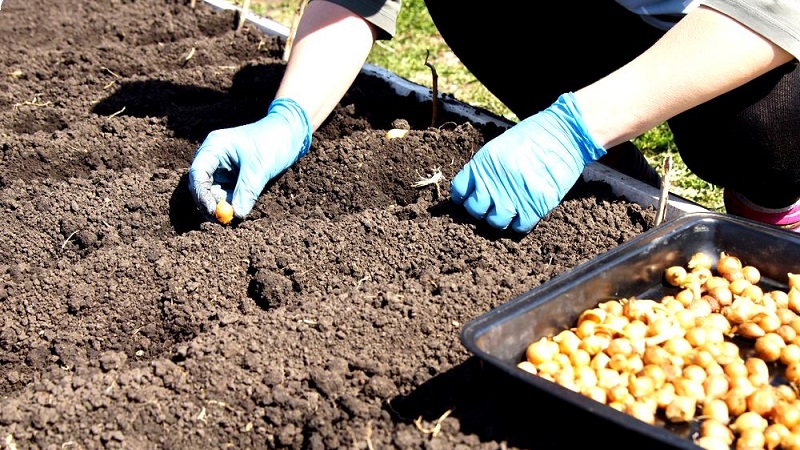
To obtain a good harvest, the seed is sorted out. Discard soft, damaged, dried out specimens with signs of disease. They will not only not germinate, but will provoke the appearance of diseases.
The bulbs are sized by:
- wild oat - up to 1 cm;
- sevok - 1-2 cm;
- samples - more than 3 cm.
Sevok is more suitable for spring planting. Before winter, wild oats are used: they grow more slowly, but take root faster. Large specimens are planted only to obtain early greens.
The selected and calibrated onions are laid out in one layer in a well-lit and heated place two weeks before sinking into the beds. This will allow the root system to form faster, increase the survival rate and resistance of the culture to adverse weather conditions both in autumn and spring.
Important! When planting in winter, the feathers of vegetables are not cut off.
The inoculum is disinfected in one of the following means:
- salt solution (1 tbsp. l. edible salt per 1 liter of boiled water at room temperature) - 5 minutes;
- copper sulfate (1 tbsp. l per 1 liter of boiled water) - 5 minutes;
- a slightly pink solution of potassium permanganate - 3-5 minutes.
Processed bulbs laid out on gauze, paper or cotton and dried for one day. The disinfected material is planted as soon as possible in order not to reintroduce pathogens.
Experienced vegetable growers additionally treat wild oats with antifungal drugs (for example, "Fitosporin-M").
How deep to plant onions for the winter
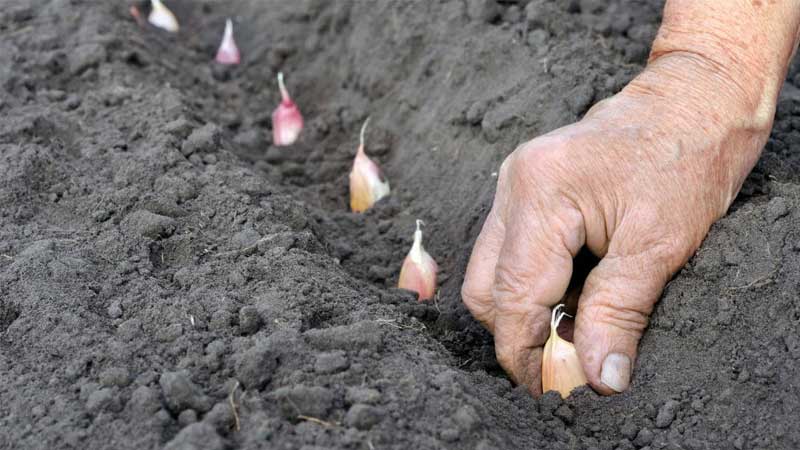
The planting depth varies for different categories of seed. For wild oat and set, it depends on the immediate size of the specimens themselves. The average planting depth of onions before winter is at least 5–8 cm, since the thickness of the soil layer above the crops should not be less than 1.5–2 cm. Recommended planting depth:
- wild oat - 3-4 cm;
- sevok - 4-6 cm;
- samples - 6-8 cm.
Scheme
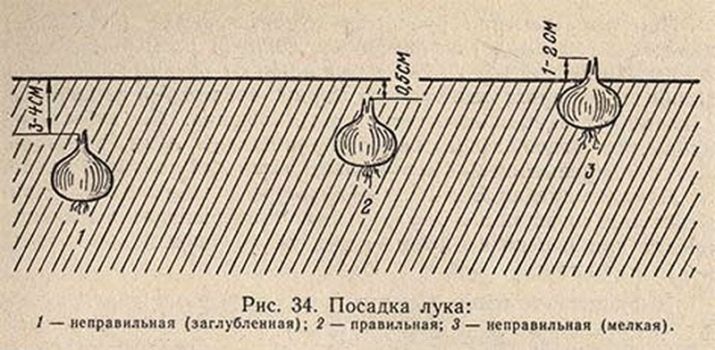
The landing pattern depends on the purpose of the bow. For the winter, sets are grown for a turnip and partially for a feather, wild oat - for a turnip, large bulbs over 3 cm - for early greens.
The grooves are allowed along or across the bed, retreating from its borders by 3-5 cm, and spilled with warm water. Distance between them:
- for wild oats - 35–40 cm;
- for seeding - 30–35 cm;
- for a sample - 15–20 cm.
Different distances are maintained between vegetables:
- wild oat - 5-6 cm;
- sevok - 7-8 cm;
- samples - 3–5 cm.
Larger bulbs grown for seed and greenery, placed close to each other.
Care features
Despite the unpretentiousness of winter onions, it needs some care in autumn and early spring, if possible - in winter. In autumn, after emergence, plantings are fed with superphosphate or nitrogenous fertilizers according to the instructions... In this case, underfeeding is better than overfeeding the plants. In dry autumn, infrequent watering is allowed.
Before mulching, the soil in the beds is loosened. Do this carefully so as not to damage the bulbs. They cover the site with agrofibre or spruce branches, mulch with straw, needles, dry sawdust, and tomato tops.
In winter, it is advisable to additionally insulate the beds with snow, this is especially important in a winter with little snow.
In the spring, the shelter is removed, leaving it only overnight at the risk of spring frosts. Further care comes down to regular loosening, watering and weeding, as with spring onions.

When to harvest
Winter onions begin to be harvested at the beginning of summer, after the feathers have dried... The yellowing and adherence of the foliage to the ground is the most striking sign that the turnips are ripe. Dig the bulbs in dry weather, gently pulling them out by the base of the feathers. The crop is dried in an open space in partial shade, avoiding direct sunlight, especially in the first days after harvesting.
Conclusion
Autumn planting of onions saves time in spring and allows you to get an early harvest, and use the vacated space for a new crop. Winter vegetables are notable for good keeping quality, are little susceptible to attack by pests and are resistant to diseases.
Due to the risks of autumn and spring frosts and harsh climatic conditions in most of Russia, this growing method is often neglected, although with proper agricultural technology, a rich harvest is obtained even in the Urals and Siberia.